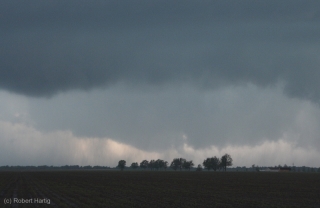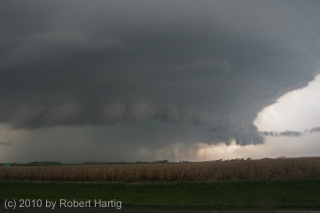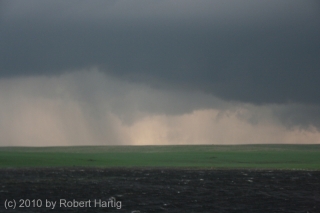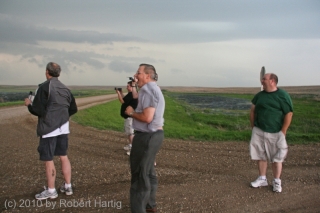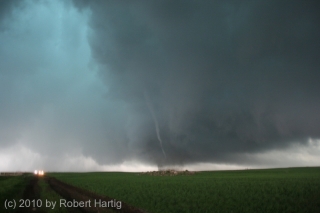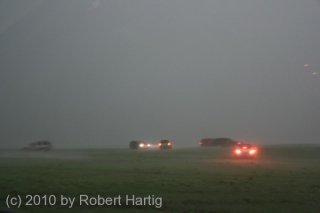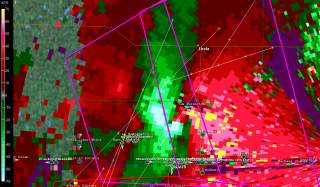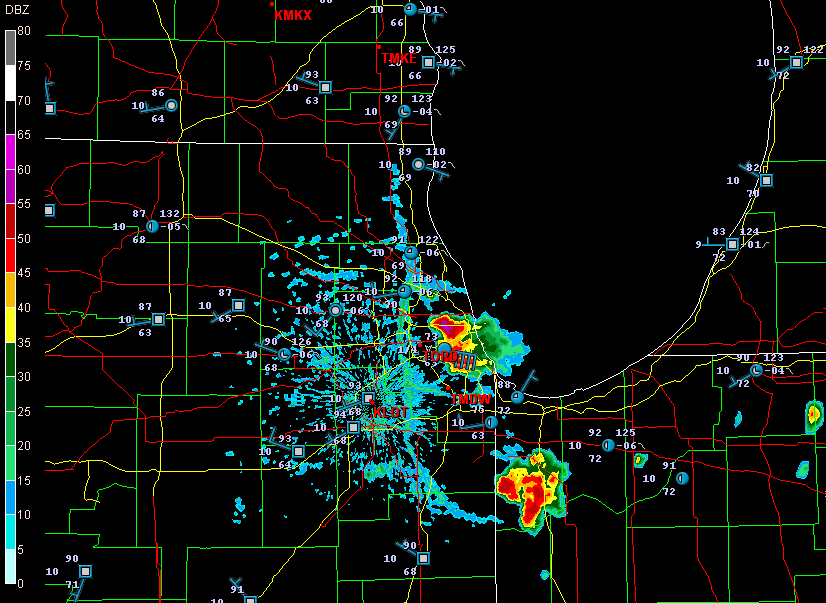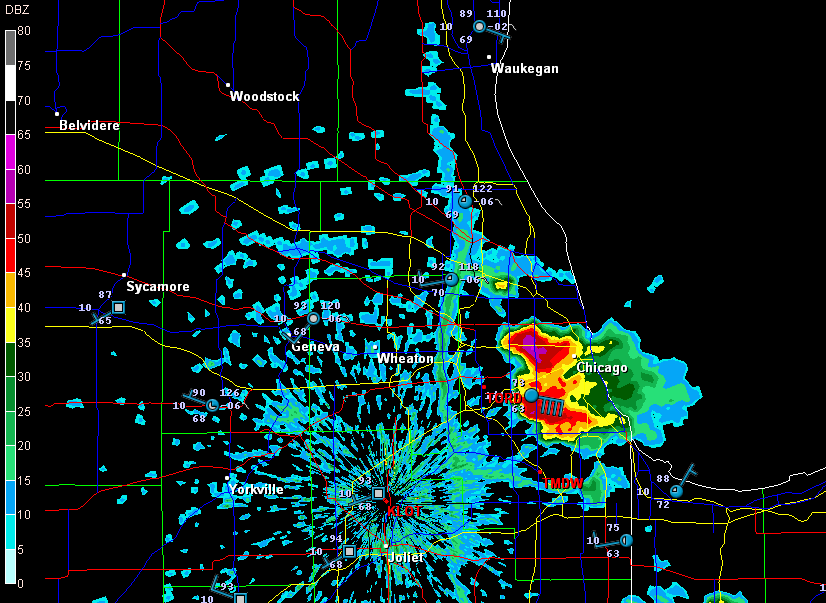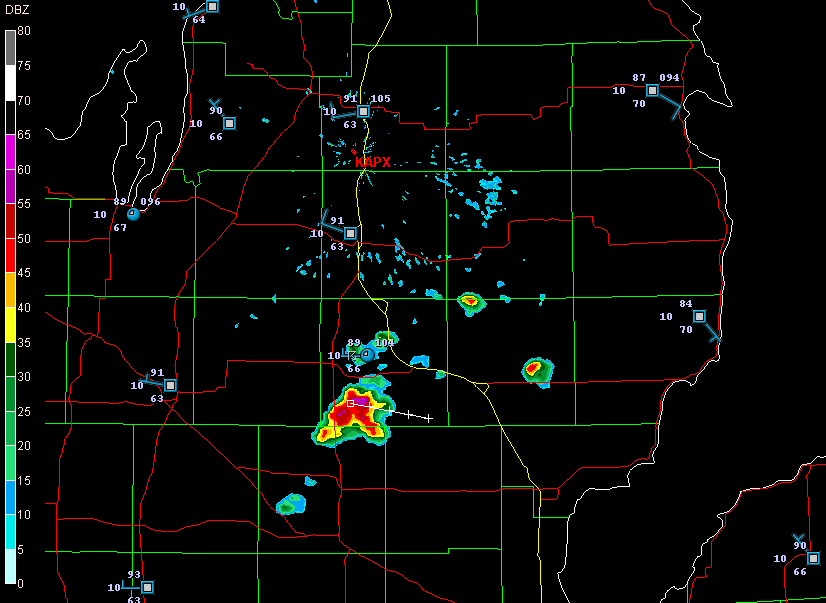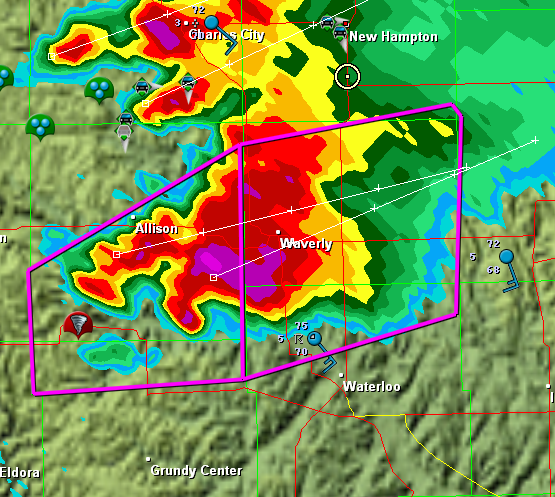In recent years, due largely to the influence of Discovery Channel’s Storm Chasers series, storm chasing has exploded as an avocation. What began over fifty years ago with a handful of individuals roaming the American heartland in pursuit of nature’s most violent and beautiful storms has evolved into a hobby practiced by multitudes, shaped by the media, and facilitated by state-of-the-art technology.
Today, equipped with a laptop, a modem stick, and radar software, a beginning chaser has an excellent chance of seeing tornadoes right out of the starting gate. But it wasn’t always so. Once there was no GR3, no mobile data, no live streaming, not even any laptops—and nowhere nearly as many chasers as there are today.
New chasers conceive of storm chasing as it is, not as it was. That’s inevitable. People live in the present, not the past, and any of us can only board the train from the platform we’re standing on. Yet the past wasn’t all that long ago—that pre-tech era when the tools of the trade were few and the likelihood of busting far greater. Those of us who came up during those simpler times treasure the experience and carry a different perspective than those who cut their teeth on techno-chasing.
To scores of chasers who have been around the block a few times, Shane Adams needs no introduction. Shane has been a storm chaser since 1996. He’s well-known as a passionate and highly experienced chaser who lives, eats, and breathes storm chasing. With six storm chasing videos to his credit, Shane is the host of the weekly podcast The Debris Show; and, with his girlfriend and fellow chaser, Bridget Geaughan, he is the coauthor of the storm chasing blog Passion Twist.
Shane was good enough to do a written interview with me covering a broad range of topics of particular interest to storm chasers. The questions and responses range from the retrospective and occasionally philosophical to the practical.
Shane is an articulate, thoughtful, and passionate interviewee with much to share. Since the article is lengthy, I’ve broken it into two parts. In this first part, Shane talks about his personal development as a storm chaser; and, in the light of his own experiences, he reflects on the state of chasing today.
In part two, which I’ll release in another day or two, Shane talks about his personal approach to forecasting and chasing. He shares his unique account of chasing the tragic May 4, 2007, Greensburg, Kansas, supercell, and he looks back on the three most outstanding chases of his career.
Enough of my introduction. Here’s part one.
.
Interview with Storm Chaser Shane Adams
.
Question: Some background stuff to begin with. Talk a bit about your boyhood. You currently live in the Fort Worth, Texas, area. Have you lived in Tornado Alley all your life?
Shane: I was born in Oklahoma City and lived there until my parents divorced at age four. After the divorce, my mother and I moved to Healdton, Oklahoma, which is in the southern portion of the state. Growing up there for me was fun, because we lived in the same house for thirteen years, and I made many lasting friendships and knew the area well. We had a pasture that butted up to our neighborhood, and my friends and I would spend countless hours playing out there, back when kids actually played outside. That was pretty much my life pre-storms, although growing up in Oklahoma my entire life, I had been aware of storms as far back as I could remember.
Q: What event, or events, first served to flip the switch of your fascination with tornadoes?
S: As I mentioned, I had always known about thunderstorms. I can remember way back, first seeing this weird word they always used on television weather warnings: tornado. I knew about severe thunderstorms but had no clue what a tornado was. My mother tried to explain it to me, but her very limited knowledge and understanding, coupled with my young mind, just didn’t really paint the picture.
Then April 10, 1979, came along. A massive F4 tornado ripped through southern portions of Wichita Falls, Texas, just eighty miles southwest of Healdton. A few months later, one of the local television stations did a story on the tornado. I was in my room when suddenly my mother started yelling for me. I ran out into the living room, and she pointed to the television. I looked at the screen and saw a huge, black, boiling mass of cloud scraping along the ground below the most ominous sky I’d ever seen. “There,” she said. “That’s a tornado.”
I was hooked for life.
Q: It’s one thing to be intrigued by tornadoes; it’s another to actually chase them. When did you first start chasing, and what inspired you to do so? What was your first chase like for you?
S: I dabbled with chasing for years before I really started, but this was nothing more than glorified spotting. I would move from one edge of town to the other, but when the storms moved on, I never followed. I did this infrequently from 1988–1995.
On April 21, 1996, I went on my first true chase, where I actually drove out of town, over the road, to try and find a tornado. However, this too was a spur-of-the-moment thing, and I only had a cheap disposable camera and a cooler full of ice in case I found big hail. There was no plan, except that if I got into hail bigger than golfballs, I would back off, fearing a tornado I couldn’t see would be close behind.
I did get hail up to golfballs that day, saved a few in my cooler, and took a few snapshots I never developed. But this was nothing I would consider a real chase by my standards. To make it a real chase for me, there must be a video camera for documentation. Otherwise, it’s just a drive.
My first “official” chase was June 6, 1996. I was working a landscaping job with a friend of mine named Greg Clark. It started to get stormy early that afternoon, so we decided to knock off early. I said on a whim, “We should go chase these storms and try to find a tornado.” Greg not only liked the idea but suggested that we grab his mother’s video camera and tape the experience. It had never crossed my mind to actually videotape a tornado, but I was wild about the idea. (As it turned out, having the video camera that day was pivotal towards me becoming a chaser).
We grabbed the video camera, stopped by my place to look at a live update from one of the local television stations, and then took off towards a storm that was tornado-warned. There was no plan; we just called it as we went. All I knew at the time was, you want to be out of the rain, so we just drove right into the heart of the storm until the rain stopped. A lowering was to our south, so we turned east to pace it. We stopped, and I started shooting video. Literally seconds after I did, a small tornado formed out of nowhere, right in the spot I was pointing at, lasting less than a minute. It was pure dumb luck, but it was a critical moment for my chasing future.
Q: That first tornado obviously hooked you. What was your growth curve as a storm chaser like from that point?
S: I laughed out loud when I read this one. To put it simply, I was horrible. For years. I got by the first four or five years on sheer passion and tenacity. I didn’t know anything about the atmosphere or that I even needed to. Computer models were something I didn’t even know existed for the first year I chased. All I was armed with was an unrelenting, unrivaled passion to see tornadoes. There really was nothing else other than the minimal, basic structural and behavioral experiences I was slowly developing as I chased more and saw more.
As the years started going by, I started to recognize patterns and tendencies purely from what storms looked like or what the sky in general looked like. By my fifth season, I was pretty good at working a storm—meaning, how I handled it once I found it—even though I knew virtually nothing about finding storms. Basically, I learned how to chase storms way before I ever learned how to forecast them.
Q: Who were some of your key influences during those early years—people who helped you learn the ropes or who simply inspired you?
S: The first storm chaser I ever heard of was Warren Faidley. I received The Weather Channel’s Enemy Wind on VHS for Christmas in 1992 and wore the thing out. I had no clue there were people out there who actually chased storms seriously. But even more, I had no idea there were several people other than Faidley who had been doing it for years.
The first storm chaser I began to seriously follow and look up to was Jim Leonard. He was bigger than life to me. I was brand-new to chasing and just discovering the wonders of my storm chasing passion. Jim was the guy who, in my eyes, had done everything I wanted to do. His dedication to the art of chasing, and the fact that he’d started around the same age as I was and was still as dedicated well into his forties, was amazing to me. I idolized him, and I’m not the star-struck type. I met him briefly at a landspout seminar hosted by Al Pietrycha in Norman in 1997. I asked him a few questions about what was, at the time, my favorite intercept video from him: his June 8, 1995, Allison, Texas, wedge tornado. It was such a thrill to actually be standing next to my hero, although he had no clue who I was or that I worshiped him LOL.
Another chaser who, in my later formative years, really reached out to me was Gene Moore. He realized how ignorant I was but also saw my passion and dedication. While he could’ve easily ridiculed me, he instead took the time to talk to me about a few things he considered the basic, important essentials for storm forecasting. Things I still use to this day, every forecast, every chase.
Q: You came up in a time when technology and the media hadn’t yet shaped storm chasing the way they do today. What was chasing like for you in those days? What benefits do you think you gained from the minimalist, old-school approach that younger chasers today are missing?
S: The main difference between chasing now and chasing when I started is the laptop computer, but that’s over-simplfying things. Back in the day, we didn’t just not have computers, we didn’t have smart phones or iPods either. Today’s chasers never have to deal with long hours on the road the way chasers did years ago. Sure, twelve hours cooped up in a vehicle is still extreme, but it definitely softens the experience when you have constant entertainment at your fingertips, the way you would at home.
Chasers today don’t talk to each other, they chat. They stream. They surf. They listen to music. There will be a carload of chasers and each one will be in their own world, playing on a cell phone. Chasers today will never know what it’s like to spend twelve hours in a car when all you have for passing the time is conversation. And many times for me personally, I didn’t even have that, because many of my past partners were champion sleepers when there was nothing exciting going on. It takes a special kind of person to willfully strap themselves in for a ride that could last over twenty-four hours, with absolutely no guarantee of seeing anything—even less of a guarantee without constant streaming data 24/7 to lead you to the storm on a string—and absolutely nothing to pass the time. These techno-generation chasers will never experience that level of dedication, and quite frankly, if many of them were to, I doubt some would stayas dedicated.
Basically now, chasing is just people doing all the same things they would be doing at home otherwise, except there’s a drive involved and maybe a storm or tornado. The “grueling, long hours” which are so often brought up by chasers praising their allegiance to their craft are nothing more than what they do every day, except they have to stop to use the potty.
I’m very grateful I was able to endure the type of chasing I did for a good number of years. We would jump in a car and drive to Missouri or Illinois from Oklahoma on a whim, with nothing to guide us except NOAA radio. We were always broke, so hotels were an extremely rare treat at best, maybe once or twice a year. Normally we’d just drive in shifts, and do straight-through chases of twenty-four hours or more. And this was with no Internet, no Spotify, and no Angry Birds. Just a carload of guys who shared one common goal: to see a tornado.
One time in 2000, we left Norman at 1:00 a.m. and drove straight through to North Dakota only to miss all the tornadoes by forty-five minutes. We stayed the night in Fargo, then drove straight back the next day, missing even more tornadoes because we got there too late again. That was a 2000-mile, two-day trip for some thunder and lightning. We had several of those back in the day, when the only thing fueling us was the desire to simply see and videotape a tornado.
There are few of today’s new chasers who would ever willfully endure that type of experience. Kids today want everything on a plate, with a remote, a keystroke, or some other too-easy device designed for no other purpose than to make an already easy life that much easier. A lot of chasers like to toot their own horn (nice pun, eh?) about how dedicated, extreme, and hardcore they are. Doesn’t take much to drive 500 miles when you know you’ve got Internet the entire way and a nice, comfy hotel bed waiting for you that night. Try it with nothing but a NOAA radio and knowing that regardless of what happens, you’re not sleeping again until you get back home the following day. That’s hardcore.
But it’s a different world, and I have to accept that. I look around, and I really can’t relate to most newer chasers. They rely on electronics for their lifeblood, they care as much about making money as simply videotaping a tornado, and they’re all so busy trying to come up with the next big thing or gimmick. For me, at the end of the day, it’s about the storms and tornadoes, period. Streaming doesn’t matter, money doesn’t matter, and every other chaser out there doesn’t matter. All that matters is my video camera and that tornado in front of it. My day ends when the last tornado ends and the setting sun bleeds away. Their day is just beginning, hustling to contact brokers or potential customers with their day’s bounty. That’s fine for them, but chasing isn’t work for me. It can’t be, because I love it too much to ruin it by putting money at the top of the priority list. Everyone likes to deliver that famous line, “Hey, if I can get some money back that’s great,” but the reality is, once you taste money from chasing, it stops being about seeing storms and starts being about selling video. Because making $$$ from chasing is too much work for it not to be the top priority.
I’m happy fading back into obscurity, with my long resume filled with amazing catches the world doesn’t value because they haven’t been splashed all over the internet and television. I’m perfectly content to sit back and watch the flame wars, the ego battles, and of course, the constant brand/money wars. I watch this blur of an activity, as it is today, and smile inside, thinking back to how simple and innocent it was so many years ago. Even more simple and innocent years before my own career started. I’m proud to have come along when I did, to get a taste of the tail-end of a great era of storm chasing. There’s no doubt I’m the chaser I am now because of the way I learned, and that’s something I cherish. I haven’t seen the most or the best, been the closest, or lived through the worst, been the most famous or the most respected. I’m just doing my own thing the best way I know how, and will continue to trudge forward, ever-attempting to pen the next chapter in my life’s storm chasing adventure.
(Coming in Part Two: personal forecasting and chase approaches, the 2007 Greensburg storm, and top three career chases.)
